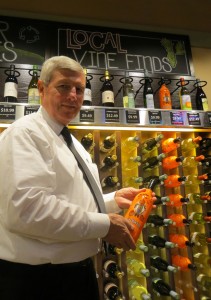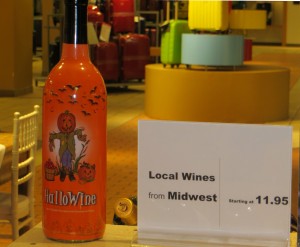Regional Wine Fighting Its Way Into Chicago
Chicago is the third largest U.S. wine market by case sales ranking behind Los Angeles and New York. One would think that demand for regional wine in a Midwestern metropolis with 9.72 million residents would not be an issue. After all, Illinois was the fourth largest wine producing state before Prohibition.
However, regional wine sales do better the farther they get from Chicago, according to Doug Jeffirs, director of wine sales for the largest wine retailer in Chicago, Binny’s Beverage Depot. According to Jeffirs, Illinois and regional wines do better at Binny’s downstate stores than in Chicago. However, Jeffir’s did note that demand for regional wine is higher in the Chicago suburbs than the city.
“In Champaign, we have a much larger regional selection and in the Bloomington store (soon to open), we’ll have an even larger regional wine selection,” Jeffirs said. “In Chicago, regional wine is definitely a case-by-case basis. We let the consumer guide us on that.”
Jeffirs said he believes that downstate Illinois’ proximity to wineries helps drive regional wine sales there, citing the sales of Alto Vineyards, which has locations near Carbondale and in Champaign.
Jeffirs and other wine purchasers in the Chicago area report regional wine sales of zero to 2-to-3 percent of their total wine sales.

Jack Farrell, wine manager at the new Mariano’s Fresh Market on Elston Avenue in Chicago next to his regional wine display
However, some Chicago retailers are increasing shelf space devoted to regional wine. At Mariano’s Fresh Markets, a rapidly expanding Chicago grocery store chain, there is a permanent display for 14 regional wines in each new store, according to Donna Goodwin of Midwest Wine Selections.
To continue reading this post, you must either subscribe or login.[login_form][show_to accesslevel=”annual-membership” ]
Goodwin’s company is the largest distributor of regional wine in Chicago and she is currently adding sales staff. “Demand for local wine is definitely building in Chicago,” she said.
While Mariano’s sees a future for regional wine, the Chicago area’s largest grocery chain, Jewel-Osco, says a lack of demand led it to discontinue Illinois wines altogether, although it carries a smattering of wines from neighboring states.
Jewel-Osco’s liquor sales and merchandising manager Kim Connery again cites demand for regional wine coming from downstate Illinois, not Chicago. “We are not seeing a significant trend for regional/local wines,” Connery says. “We carry Tabor Hill, out of Michigan, in many stores, and St. James, from Missouri, in our Bloomington/Normal stores,” she said. “Our customer base tends to prefer national items.”
Several smaller Chicago-area retailers say they lack hard numbers but get the impression that regional wine sales in Chicago lag behind other markets in neighboring states like Michigan.
“I’m sure Michigan is a much better regional wine market than Chicago,” said Todd Hoffman, wine associate at Standard Market in west suburban Westmont, which features many boutique wines. “I don’t know why (Chicagoans) aren’t hip to it.” Consequently, the Chicago market is saturated by California and international labels, often with little variation in selection from wine store to wine store.
See related story: Champaign Illinois Takes on Champagne France
In some respects, the lack of regional wine in Chicago is a classic “chicken and egg” situation. Several retailers suggested they would carry more regional wine if it sold more. Yet, if regional wine is on the shelf at all in Chicago, it’s often below eye level in the back of the store.
Chicagoans can also be more status conscious than other Midwesterners and less willing to give up old stereotypes about regional wine. At Sandburg Wine Cellars, which is located at Potash Markets in Chicago proper, wine manager Alan Blum speculates that many Chicagoans associate Midwest wines with being “all sweet and boring.”
Still, several smaller wine merchants say more customers are asking for regional wines. For example, Sandburg Wine Cellar has only been carrying regional wines for the last six months, Blum said. “I see a lot of potential, otherwise I wouldn’t be doing it,” Blum said. “I think (sales) will be more and more, as long as the quality is there.”
National consumer trends like reducing the “carbon footprint” and a preference for buying local may also help regional wines in Chicago. Blum said he believes the “buy local” movement” has already has helped mead and cider sales.
There is “definitely more awareness” of regional wines, said Tracy Kellner, owner of Provenance Food and Wine, a specialty shop with two locations on the North Side of Chicago. However, Kellner also added regional wine only accounted for about 2 percent of her wine business.
At Macy’s on State Street, former wine columnist Dee Coutelle oversees an offering of 20 regional selections. (Of 750 Macy’s locations in the U.S., the Macy’s on State Street is the only store to carry wine.) “We call them local wines, not even regional, because they are so close,” Coutelle said. “I’d have to say sales are steady (at Macy’s) … But I think as a buy-local trends heats up, so will sales.”
According to Alex Basich, owner of a Chicago wine store called Noble Grape, there is a seasonality to regional wine sales in Chicago. Basich said regional wine sales increase during the warmer months. “I think people who have lake houses in Michigan visit local wineries and make requests when they get home,” Basich said.
The swing toward regional wine sales in summer is also evident at Binny’s, Jeffirs said. “Maybe it is all the tastings at the wineries,” he speculated.
So what is the future of Chicago wine sales for regional and in-state producers?
“Tough roads,” said Martin Cody, founder of the Internet-based Cellar Angels and owner of a brick-and-mortar shop WineStyles in Chicago. WineStyles, he said, has carried local wines in season but currently they have none. “They lack the marketing machine that is Napa/Sonoma, get little to zero exposure in the trade rags – Wine Spectator, Wine Enthusiast, Wine Advocate, etc – and have limited exposure,” he said.
[/show_to][password-recovery-link text=’Lost Password? Click here for password recovery.’]



My wife, a couple of friends, and I have traveled to several Midwest states to sample wine. Our ‘winery tours’ have included trips to Southern Illinois, Central Missouri, Southeast Missouri, Northern Wisconsin (Door County area), Southern Indiana, Southern Ohio (around Cincinnati), Northern Michigan (Traverse City area), Southwest Missouri, and Kentucky. We have found that Midwest wines are just as good (if not better) and cheaper than California or European wines. It is frustrating that there are not more Midwest wines sold in the Chicago area. (We were all born in Chicago and now live about 30 miles Northwest of Chicago.) We do have a few stores here that sell a limited amount of MW wine. Jewel, Meiers, and Woodmans. We have purchased wines from St. Julian (SE Mich), Leelanau (Traverse City), and St.James (SE Missouri) in these stores. I wish that we could find more.
The local distributors need to get more Midwest Wines into their stable and push harder for good shelf space. I believe that it will happen eventually. Chicago (basically Cook County) is a very hard area to break into as there are a lot of closely held interests regarding alcohol and who gets to sell it.
Keep up the good reporting! We really enjoy reading about the local wineries as we have visited many of them.
Richard,
So refreshing to read your comment! We are a distributor focusing on local/regional wines and ciders and we are working very hard to get more local wines on the shelf at retailers and by the glass at restaurants.
You will find some good local wine selections in the NW ‘burbs at Dobby’s in Palatine, Mariano’s, Sunset Foods and other single retailers. You can visit our website or follow us on facebook to see as we add new sellers.
Cheers to localpours!
Kelly Kniewel